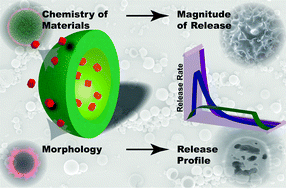Encapsulation of actives for sustained release†
Abstract
Encapsulation of actives in miniature reservoirs, called microcapsules, is used for protection and in particular controlled release of the active. Regarding controlled release applications, the most common function of the microcapsule is to sustain or extend the release of the active. A number of encapsulation methodologies are available including; internal phase separation, interfacial polymerization, formation of multiple emulsions, Layer-by-Layer adsorption of polyelectrolytes and soft templating techniques, all of which are reviewed in this Perspective. The choice of method depends on the nature of the active (hydrophilic/hydrophobic, size, physical state) and on the intended release rate and release profile. Ways to manipulate the release of the active by tailoring the physicochemical properties of the microcapsule are reviewed. Moreover, appropriate diffusion models are introduced to describe the release profile from a variety of microcapsule morphologies, including Fickian diffusion models and Brownian motion, and the meaning and the misuse of the term “zero-order release” are briefly discussed.


 Please wait while we load your content...
Please wait while we load your content...